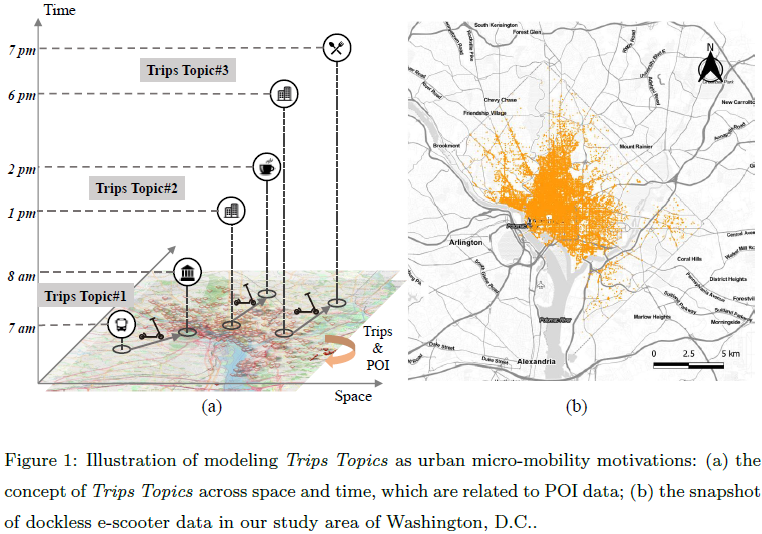Over the last two years, we have witnessed the ever-fast growth of micro-mobility services (e.g., e-bikes and e-scooters), which brings both challenges and innovations to the traditional urban transportation systems. For example, they provide an opportunity to better address the “last mile” problem due to their convenience, flexibility and zero emission. As such, it is essential to understand why and how urban dwellers use these micro-mobility services across space and time. To tackle this challenge, we, a joint research team from Heidelber University, HeiGIT, Utrecht University, University of Warwick, and Tongji University, recently published a paper in Computers, Environment and Urban Systems.
In this paper, we aim to understand spatiotemporal trip purposes of urban micro-mobility through the lens of dockless e-scooter user behavior. We first develop a spatiotemporal topic modeling method to infer the underlying trip purpose of dockless e-scooter usage. Then, using Washington, D.C. as a case study, we apply the model to a dataset including 83,002 valid user trips together with 19,370 POI venues and land use land cover data to systematically explore the trip purposes of micro-mobility across space and time in the city. The results confirm a set of uncovered 100 Trips Topics as an informative and effective proxy of the spatiotemporal trip purposes of micro-mobility users. Though the proposed approach cannot yet fully replace traditional OD surveys in understanding user trip purposes considering the sophisticated socio-economic driving factors, it provided a promising low-cost and mode-oriented complement to standard OD user surveys. As potential applications, the modeling approach developed and the insights shared in this paper will be helpful for city authorities and policymakers to evaluate the impact of micro-mobility service in addition to existing public transit network and adjusting their transportation regulations accordingly, for dockless e-scooter companies to optimize their vehicle deployment by wisely reallocating their vehicle fleets, and also for mobile APP providers to estimate trip purposes based on their mobility patterns and provide timely POI recommendations
In conclude, our findings in this work provide enlightening insights for city authorities and dockless e-scooter companies into more sustainable urban transportation planning and more efficient vehicle fleet reallocation at a city-level.
Li, H., Yuan, Z., Novack, T., Huang, W., Zipf, A., (2022) Understanding spatiotemporal trip purposes of urban micro-mobility from the lens of dockless e-scooter sharing. Computers, Environment and Urban Systems, 96, 101848, June 2022, https://doi.org/10.1016/j.compenvurbsys.2022.101848
Previous related work:
- Huang, W. and Li, S. (2018): An approach for understanding human activity patterns with the motivations behind. International Journal of Geographical Information Science (IJGIS), 2018.
https://doi.org/10.1080/13658816.2018.1530354 - Huang, W., Xu, S., Yan, Y. and Zipf, A. (2018): An exploration of the interaction between urban human activities and daily traffic conditions: A case study of Toronto, Canada. Cities, 2018. https://doi.org/10.1016/j.cities.2018.07.001
- Novack T., R. Peters, A. Zipf (2018): Graph-Based Matching of Points-of-Interest from Collaborative Geo-Datasets. ISPRS International Journal of Geo-Information, 7(3), 117-134. DOI:10.3390/ijgi7030117.
- Yan, Y., M. Eckle, C.-L. Kuo, B. Herfort, H. Fan and A. Zipf (2017): Monitoring and Assessing Post-Disaster Tourism Recovery Using Geotagged Social Media Data. International Journal of Geo-Information, ISPRS IJGI. 6(5), 144; doi:10.3390/ijgi6050144
- Rousell A. and Zipf A. (2017): Towards a landmark based pedestrian navigation service using OSM data. International Journal of Geo-Information, ISPRS IJGI, 6(3): 64.
- Steiger, E., B. Resch, J. Porto de Albuquerque, A. Zipf (2016): Mining and correlating traffic events from human sensor observations with official transport data using self-organizing-maps. Transportation Research Part C: Emerging Technologies. Vol 73, Dec.16, pp 91–104. http://dx.doi.org/10.1016/j.trc.2016.10.010
- Zipf, A. (2002): Location aware mobility support for tourists. Trends & Controversies. IEEE Intelligent Systems. Journal. Special Issue on “Intelligent Systems for Tourism”. November/December 2002. S.57-59.



